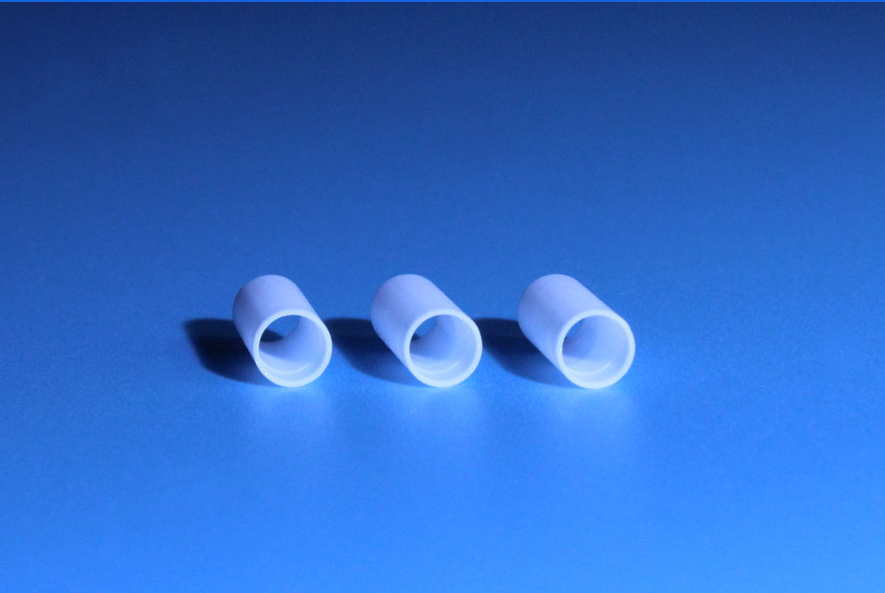Macor ceramics can be used to manufacture precision parts, but its processing characteristics are different from metals and plastics. The macor ceramic is composed of interlocking plate-like mica crystals in a glass matrix. It is these crystals that prevent microscopic fractures, and the tool tip does not diffuse into the material, allowing it to be processed in a controlled manner. During the processing, the tool smashes and tears the surface of macor ceramics, producing fine powder of crystals and glass. The crystals are very small, and macor ceramics have a good surface finish during processing. After processing, the parts are cleaned and ready for use without further processing (such as firing).

Configuration
Macor ceramics have no elasticity, so when processing small or precision parts, please ensure that the load is evenly distributed. If possible, use soft jaws. It is very worthwhile to spend some time understanding how the material behaves during processing. Try some simple tasks, such as drilling, turning and milling, and you will see how the material is processed. This information lays the foundation for good machining practices, but don't try to use tools and speeds to get the best machining performance from your equipment.
Macor ceramics can be processed with high-speed steel tools, but tungsten carbide tools are strongly recommended (tools are not recommended for ceramic tips). If the macor ceramic surface is worn out by the tool, or the tool squeaks with excessive force, the tool should be stopped and sharpened.
If you have no experience in machining macor ceramics, you should work at a lower speed (keep the workpiece cool) and use a smaller depth of cut until you have confidence in the material to be processed. It is usually required to maintain a controlled surface finish.
Use coolant
Although macor ceramics is a high temperature resistant material, it is necessary to maintain the processing effect of the material and the tool at the same time in order to obtain the best results. Water-soluble cutting fluid can improve the cutting action, it can capture and wash away the debris generated during the machining process to protect the machine tool. If the fluid is to be recirculated, it is recommended to use a settling tank. The powder produced in the process is abrasive to the machine, so attention must be paid to cleaning and machine maintenance.
Sawing
Use a carbide grinding wheel blade with a belt speed of 30 m/min, or a diamond or silicon carbide cutting wheel.
Turning
Using carbide tools, the recommended turning speed for macor ceramic 5mm-10mm rods is about 600 rpm. The macor ceramic is reduced to 400 rpm 25 mm rod, the feed rate is 20-30 mm/min, the rough cutting depth is 2-4 mm, and the finishing cutting depth is less than 1 mm. The side rake angle, the end clearance angle and the side clearance angle should be about 5°, the recommended side cutting edge angle is 15°-45° and the nose radius should be greater than 0.8mm. Thread cutting can also be performed at low spindle speeds, and the typical cutting depth is 0.025-0.040 mm per pass.
Milling
The typical cutter head speed is 1000-1500 rpm, and the chip load per tooth is 0.05 mm. The depth of cut is the same as turning. Down milling prevents the material from being pulled out of the edge of the macor ceramic.
drilling
For macor ceramics to process holes up to 5 mm in diameter, the spindle speed is 1000-1500 rpm and the feed rate is 20-30 mm/min. It has been proven to be effective. Keep loosening the drill groove, especially for small diameter holes, check the sharpness of the drill bit every 25-50 holes. To prevent cracking, use a backing plate or chamfer the hole entrance and exit before drilling through the thickness. Ultrasonic drilling can be performed on macor ceramics.
Interstitial hole
Make the clearance hole one size larger than the recommended metal size (usually 0.1-0.2 mm larger). Chamfer both ends of the hole to prevent chipping. 4-blade taps are better than 2-blade taps. Slowly run the faucet in the same direction (turning the faucet back and forth may cause debris) and rinse with water or coolant to remove dust. Wire thread inserts can be used with macor ceramics.
Grinding and polishing
Although silicon carbide and alumina grinding wheels can be used to polish macor ceramics, diamond grinding wheels work best. Always use water cooling. Before final polishing with alumina or cerium oxide powder, use 400 grit silicon carbide for polishing.
Remember, when processing brittle materials, always avoid physical shocks. The above is the technical summary of the macor ceramic processing technology by Huamin ceramics technicians. If you have any related questions, please consult
